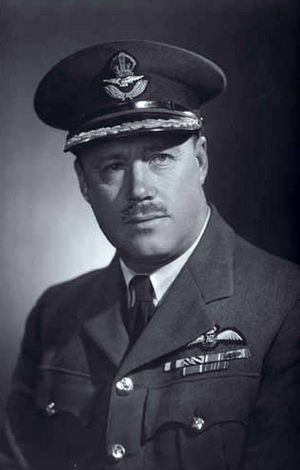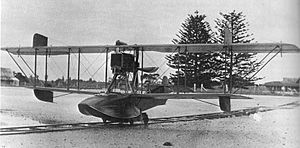Keith Caldwell facts for kids
Quick facts for kids
Keith Logan Caldwell
|
|
|---|---|

Group Captain Keith Caldwell c. 1944
|
|
| Nickname(s) | Grid |
| Born | 16 October 1895 Wellington, New Zealand |
| Died | 28 November 1980 (aged 85) Auckland, New Zealand |
| Allegiance | |
| Service/ |
New Zealand Army Royal Flying Corps Royal New Zealand Air Force |
| Years of service | 1914–1919 1930–1946 |
| Rank | Air Commodore |
| Unit | No. 8 Squadron (1916) No. 60 Squadron (1916–17) No. 74 Squadron (1918) |
| Commands held | No. 74 Squadron (1918) RNZAF Base Woodbourne (1939–42) RNZAF Base Wigram (1942–44) |
| Battles/wars | First World War Second World War |
| Awards | Commander of the Order of the British Empire Military Cross Distinguished Flying Cross & Bar< Mentioned in Despatches (2) Croix de guerre (Belgium) |
Air Commodore Keith Logan "Grid" Caldwell was a brave New Zealand pilot. He was a "flying ace" in the Royal Flying Corps during World War I. This means he shot down many enemy aircraft. Later, he became a high-ranking officer, an Air Commodore, in the Royal New Zealand Air Force during World War II. He earned several important awards for his courage and skill.
Contents
Early Life and Joining the Military
Keith Logan Caldwell was born in Wellington, New Zealand, on October 16, 1895. When he was young, his family moved to Auckland. He went to school at King's College and Wanganui Collegiate School. Even in school, he was interested in the military and joined the Defence Cadet Corps. After finishing school, he worked as a bank clerk.
Learning to Fly in New Zealand
When World War I started in August 1914, Keith tried to join the New Zealand army but was not accepted. He really wanted to fly! So, in October 1915, he paid £100 to join the first class at the New Zealand Flying School. This school was run by two brothers, Vivian and Leo Walsh. Keith learned to fly on special planes called Walsh Brothers Flying Boats. He used to call airplanes "grids," like bicycles, which is how he got his nickname. He learned very quickly and flew solo (by himself) on November 28. However, bad weather stopped him from finishing all the tests needed to graduate.
Joining the Royal Flying Corps
Even without fully graduating, Keith sailed to England in January 1916. He brought a letter from the Walsh brothers saying he was a good pilot. Because of this, he was able to join the Royal Flying Corps, which was the air force of the British Army. He trained at different places in England. On July 29, he joined No. 8 Squadron. This squadron flew Royal Aircraft Factory B.E.2 planes for observation (looking at enemy positions) near a place called Arras. For the next four months, he flew many missions. He had at least seven fights with German planes. In one fight on September 18, he and his observer (the person who helped him spot enemies) shot down a Roland C.II plane.
World War I Flying Ace
Towards the end of 1916, Caldwell moved to No. 60 Squadron. This squadron flew faster Nieuport 17 fighter planes. By February 1917, he was promoted to captain and became a flight commander, leading other pilots. By September, his squadron started using Royal Aircraft Factory S.E.5 planes, which were even better fighters. By this time, Caldwell had shot down more enemy planes, mostly Albatros scout planes.
Awards for Bravery
Keith Caldwell received the Military Cross on September 17, 1917. He had already achieved his first victory in an S.E.5 plane. The award was given for his great bravery and skill in leading patrols. The official announcement said he once led five planes against twelve enemy aircraft and forced them all down. It also said he had personally destroyed five enemy planes and had over fifty air battles, always showing amazing skill and courage. In October 1917, he was sent back to England to teach new pilots.
Leading No. 74 Squadron
In February 1918, Caldwell was promoted again to major and put in charge of No. 74 Squadron. This squadron also flew the S.E.5 fighter plane. He took the squadron to France the next month. They were based at Clairmarais and flew their first mission on April 12.
Caldwell received the Distinguished Flying Cross in December. This award was for being a "fine fighting airman of courage and determination." One example given was on September 4, when he and another pilot attacked four enemy Fokker biplanes, and he shot one down. He was credited with destroying five enemy machines.
Keith Caldwell was never shot down himself. He even survived a mid-air crash with another pilot from his squadron, Sydney Carlin. He managed to guide his damaged plane close to the ground before jumping out just as it crashed. Caldwell also fought against famous German flying aces like Werner Voss and Hermann Becker, though these fights didn't have a clear winner. He was a natural pilot with excellent eyesight, which helped him find enemy planes. However, he wasn't the best shot, which sometimes meant he couldn't destroy the planes he fought.
One of the pilots under Caldwell's command was the famous flying ace Mick Mannock. Caldwell admired Mannock's skills in air combat. However, Caldwell also disagreed with Mannock's harsh approach to enemies. Caldwell believed in treating defeated enemies with respect, unlike Mannock, who was known for being very aggressive.
Under Caldwell's leadership, No. 74 Squadron was very successful. They claimed 140 enemy aircraft destroyed and 85 forced down "out of control." They only lost 15 pilots. Caldwell's last combat mission was on October 30, where he claimed his ninth victory against a Fokker D.VII fighter. Overall, he is credited with destroying 11 aircraft, sharing credit for 2 destroyed, sharing credit for 1 captured, and forcing 10 (and 1 shared) planes down "out of control."
Between the World Wars
After World War I ended, Caldwell returned to New Zealand in August 1919. He worked for his father for a year, then bought a farm in Glen Murray. On May 16, 1923, he married Dorothy Helen Gordon, who was the sister of another flying ace, Frederick Stanley Gordon. They had two daughters and two sons.
Keith Caldwell remained very interested in flying. He helped start the Auckland Aero Club and was its first club captain. In 1924, when the part-time New Zealand Air Force was created, Caldwell was the most senior officer among the 72 original members, who were all former Royal Air Force pilots. This part-time force later became the Territorial Air Force (TAF) in 1930. Caldwell, now a wing commander, became its leader. His command included four squadrons, but they didn't have their own planes. They relied on the Royal New Zealand Air Force for equipment. In 1935, he received the King George V Silver Jubilee Medal.
World War II Service
During World War II, Keith Caldwell served in the Royal New Zealand Air Force (RNZAF). He was the commander at Woodbourne near Blenheim and later at Wigram near Christchurch. In 1944, he was sent to India, and in 1945, to England. He was promoted to acting Air Commodore, and then officially became an Air Commodore in 1946. Caldwell was also made a Commander of the Most Excellent Order of the British Empire (CBE) in 1945. He received another award, a bar to his Distinguished Flying Cross, and was mentioned in official reports twice for his bravery. He also received the Croix de Guerre from Belgium.
Later Life and Legacy
Caldwell retired from the RNZAF in 1956 and became a farmer in South Auckland. He continued to be interested in military aviation. In 1960, he helped start the New Zealand 1914–1918 Airmen's Association with Ronald Bannerman and Leonard Isitt. Members of this group met every year to share stories about their experiences during the war. Keith Caldwell moved to Auckland in 1970 and passed away from cancer on November 28, 1980.
Images for kids






